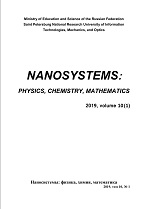|
This article is cited in 2 scientific papers (total in 2 papers)
Electro chemical and photo catalytic studies of MnO$_2$ nanoparticle from waste dry cell batteries
M. Mylarappaab, V. Venkata Lakshmia, K. R. Vishnu Maheshc, H. P. Nagaswarupad, S. C. Prashanthad, D. M. K. Siddeswarad, N. Raghavendrae
a Research Centre, Department of Chemistry, AMC Engineering College, Bengaluru-560083, Karnataka, India
b Department of Studies and Research in Chemistry, Tumkur University, Tumkur-572103, Karnataka, India
c Department of Chemistry, Dayananda Sagar College of Engineering, Bengaluru-560083, Karnataka, India
d Research Centre, Department of Science, East West Institute of Technology, Bengaluru-560091, Karnataka, India
e CMRTU, RV College of Engineering, Bengaluru-560059, Karnataka, India
Abstract:
The objective of the existing research was essentially focused on recovery of MnO$_2$ nanoparticles from consumed dry cells by employing adapted hydrometallurgical process. Experimental tests for the recovery of MnO$_2$ present in the dry cell batteries have been carried out by an acidic reductive leachant, namely oxalic acid. The elemental compositions of the recovered metals from dry cells were confirmed by Energy Dispersive X-ray analysis (EDAX). Surface morphology of the recovered metals was examined using Scanning Electron Microscopy (SEM). Phase composition of the recovered metals from dry cell batteries were confirmed from X-ray Diffract meter (XRD). Cyclic Voltammetry (CV) studies were carried out to clarify the reversibility of the reactions. The obtained MnO$_2$ catalyst was applied for the degradation of different nonvolatile dye compounds such as Indigo carmine (IC) and Rhodamine B (RB). The performance of MnO$_2$ shows fast degradation of dyes of high concentration.
Keywords:
Dry cell batteries, recovery, Zn, Mn, electrochemical, catalytic activity.
Received: 05.02.2016
Citation:
M. Mylarappa, V. Venkata Lakshmi, K. R. Vishnu Mahesh, H. P. Nagaswarupa, S. C. Prashantha, D. M. K. Siddeswara, N. Raghavendra, “Electro chemical and photo catalytic studies of MnO$_2$ nanoparticle from waste dry cell batteries”, Nanosystems: Physics, Chemistry, Mathematics, 7:4 (2016), 657–661
Linking options:
https://www.mathnet.ru/eng/nano260 https://www.mathnet.ru/eng/nano/v7/i4/p657
|

| Statistics & downloads: |
| Abstract page: | 52 | | Full-text PDF : | 17 |
|



 Contact us:
Contact us: Terms of Use
Terms of Use
 Registration to the website
Registration to the website Logotypes
Logotypes